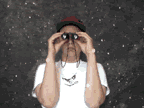 |
sally mckay talks, essays, etc. BACK TO BLOG / BACK TO GREY GOO |
This post represents a talk I performed at the Art Gallery of Ontario, on October 20, 2004, as part of the Global Theory Slam, an evening of discussion in relation to an exhibit of work by Mark Lombardi. All the illustrations were done by me on file cards and passed around the audience. A few of them were scooped up so those ones have be faithfully re-drawn in order to present the full complement of illustrations here.
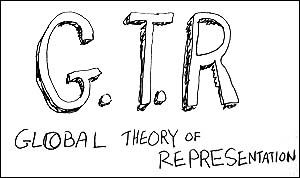 | I am not enough of a detail person to excell at conspiracy theories, but I figured I'd better show up tonight armed with a Global Theory, so I invented one called GTR. This stands for Global Theory of Representation. |
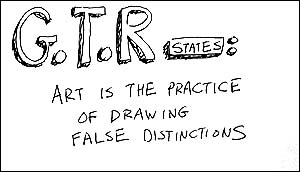 | The Global Theory of Representation states: Art is the practice of drawing false distinctions. |
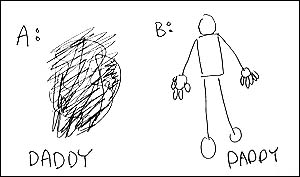 | What do I mean by this? Here is an example. When children are learning to draw people, they start by making pictures of sort of squiggley masses. After a while they learn to create an outline that will define the bounded area of a person. This exercise of drawing lines around things is a very useful tool, but it does not necessarily create the most truthful picture, because in some ways people are constructed much more like squiggley masses than like bounded shapes. |
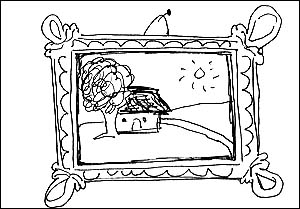 | Another example of false distinctions is the act of framing. In art, there are two important ways to work with framing. One is very familiar, the act of putting a nice frame around a picture. This is where you start with some art, and then adorn or accessorize it as a means of defining it's importance to you, and this activity is something we all recognize. It is also a means of drawing a distinction between the art inside the frame, and the regular normal objects all around it. We literally build a shape, or boundary, around the art in order to see it as separate from everything else. |
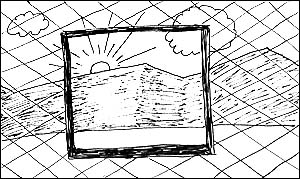 | The other type of framing may be harder to recognise, but I believe it is just as common. This is the kind of frame where you first create a structure, or shape, and then wait to see what happens inside of it. There is a lot of art that employs this method of framing. I will give you some examples... |
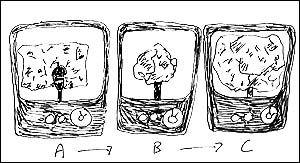 | This image represents a video by David Askevold. In the video, a microphone sticks up into the middle of the frame, or screen. The artist wraps a piece of tinfoil around the microphone, and continues to do this until the frame is filled. There is a visual effect that takes place as the frame fills with foil, and also an audio effect as the sound becomes increasingly muffled. |
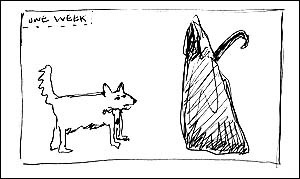 | This drawing is of a famous performance by Joseph Beuys in which he flew to America and spent a week in a gallery space with a coyote. In this instance the parameters of the frame are respresented by the time (a week), and by the confines of the space. Whatever happened inside the frame was the art. |
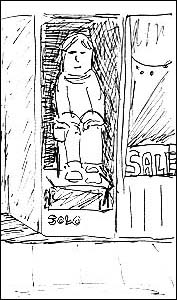 | Next is a very poor drawing of a performance by Germaine Koh. Much of Koh's work operates in this way, within frames. In this performance she sat very still in a small window gallery on Queen St. West, called Solo gallery. Koh employs both kind of framing in this piece. |
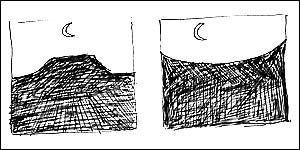 | This is an image of a work by James Turrell. Turrell is a famous artist who works with frames. |
| I propose that all art can be looked at in the context of framing, or drawing false distinctions. To test this theory, I have applied the GTR to the three art shows that I have seen most recently, and I think you will see that it plays out quite well. | |
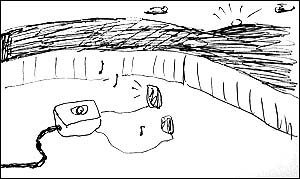 | Sarah Peebles and Rob Cruickshank did a sound performance on a rooftop on Qeen West. Lovely tones recorded from Sarah playing a mouth organ called a sho were triggered by a sensor that was recording the changing light as the sun set. The piece started when the light got dim enough to trigger the sensor, and ended when the darkness took over and tripped the sensor once again, this time stopping the sound. The frame was the length of time that it took for the sun to set. |
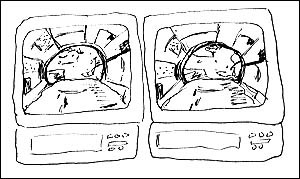 | Lorna Mills has a big show up at the Robert Mclauglin gallery. I believe that she is intentionally playing with these false distinctions and thereby messing with our heads. In one piece, she shot a video of a picnic scene through the bottom of a drinking glass that had a Mondrian pattern on it. (She then displayed the piece on two adjacent monitors to create an effect like looking through binoculars). This work refers directly to both kinds of framing, as Mills is adorning the activity in the background with the Mondrian pattern that surrounds it, plus she is setting up a bounding shape and waiting to see what transpires inside of it. This is a very conscious reference to the frame. |
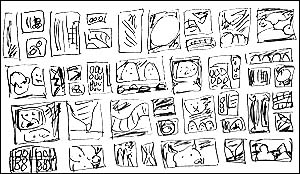 | Scott Carruthers uses frames like crazy. He has a really excellent show up at Hamilton Artists' Inc. that fills three walls with tiny frames. Inside each frame is an iconic, mythical, punk rock type drawing. In this work the false distinctions become abundandtly clear. The only limit to the number of strong cultural images that could appear inside these frames is Carruthers' physical capability to produce them. In this way the human physiology itself becomes like a kind of frame. Our brains/minds range over much wider and more complex territory than we can ever put down on paper. |
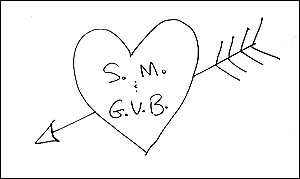 | This business of framing, or drawing false distinctions is not limited to art. I believe that the practice of drawing shapes around aspects of the universe is a genetically programmed human impulse. |
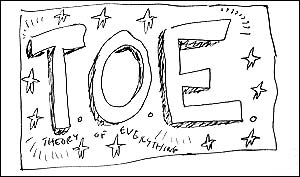 | Of course I have no evidence to back this up and I'm an artist not a scientist. Scientists, though, are doing this all the time. Just look at big science physicists who are desperately reaching for the TOE. That stands for Theory of Everything. |
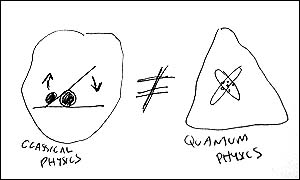 | The big problem for physics is that we are operating withing two completely different frames at the same time. Classical physics which describes levers, and force, and all that stuff that we observe in our day to day, does not jive with Quantum physics which describes the behaviour of particles, and waves, and things that are very small. |
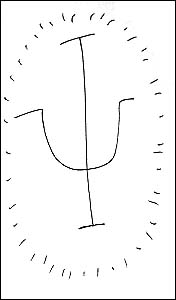 | Having two compeltely different shapes in physics is bugging everyone, and they are all trying and trying to come up with one big shape that everything can fit into. So we get phsysicists like the cosmologist James Hartle, who believes that he can write an equation that describes the entire wave form of the universe. |
| Of course in order to achieve this kind of thing, we have to wrap our heads around models like these [below]. The first describes a standard theory of the universe that starts with the big bang and progresses outwards through space time. The second represents the "no boundary" theory in which there is no big bang, the universe has no beginning point, but rather a rounded edge that continually folds back on itself, and near this rounded edge there is a zone where Space Time does not exist and we only have Space Space. It's trippy. | |
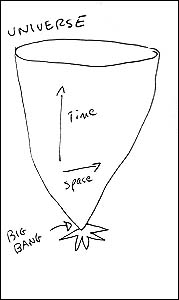 | 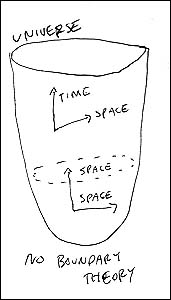 |
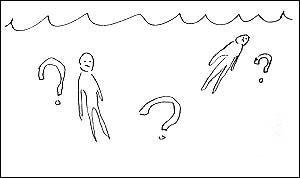 | There is a sense of excitment when we are pushed to the limit of our abilities to draw shapes around the world. But there is also a sense of danger and in some cases desperation. There is an urgency to map-making. If we enter a territory where what we know, or what we think, or what we hope cannot be drawn into any shape, then we lose hold of ourselves. |
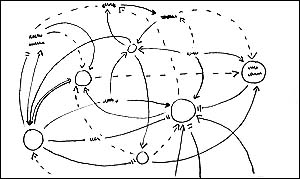 | It is possible that this what happened to Mark Lombardi. Another example of this type of thing is the story of physicist John Nash, which was depicted in the dreadful movie "A Beautiful Mind." The story goes that Nash destroyed his mind by pushing it into just such abstract territory. |
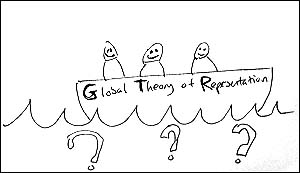 | The good news is that the GTR is robust, and for the most part we can rely on our innate ability to draw false distinctions to keep us floating when we are in weird waters. |
BACK TO BLOG / BACK TO GREY GOO